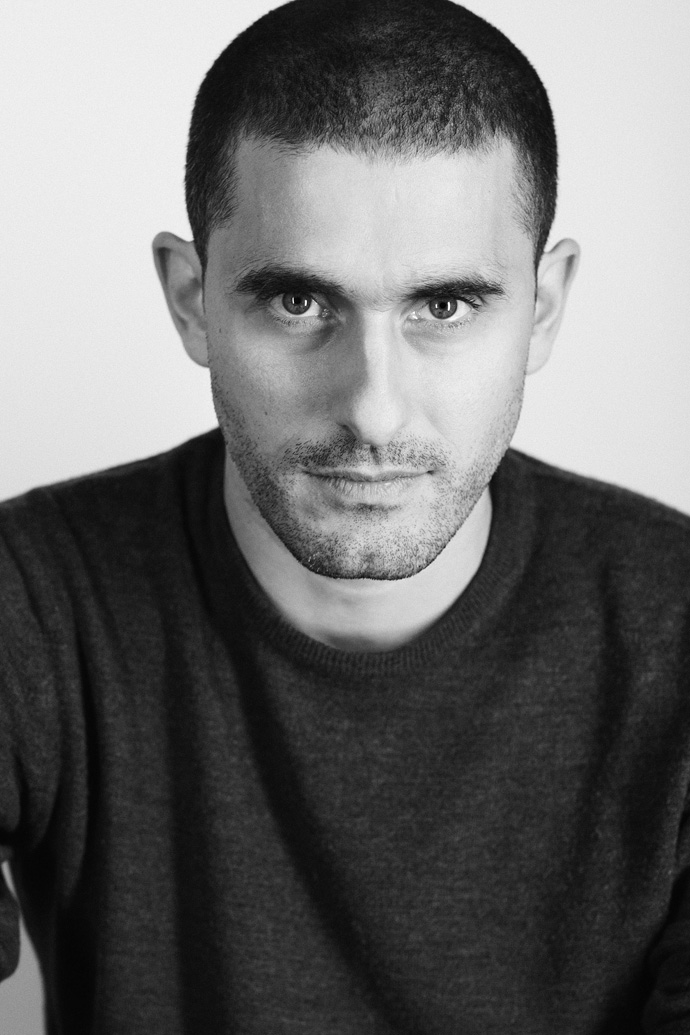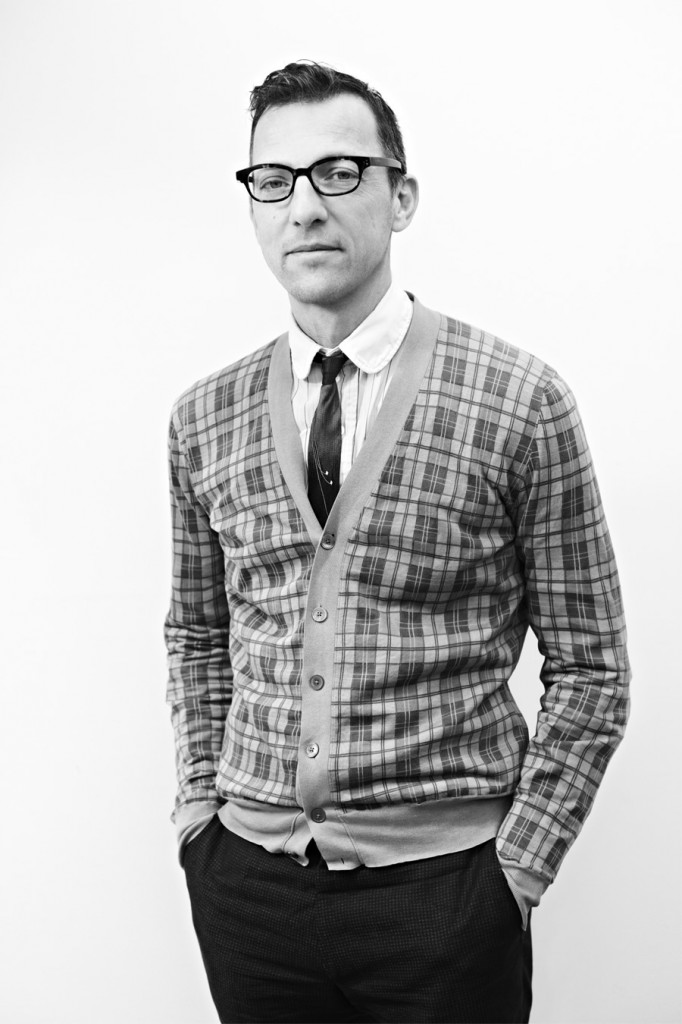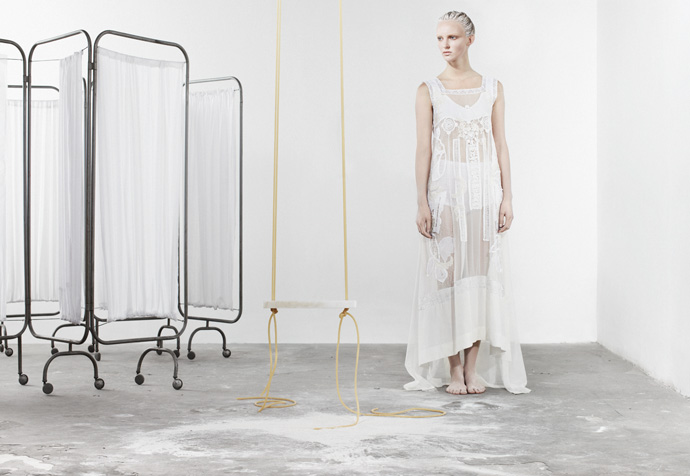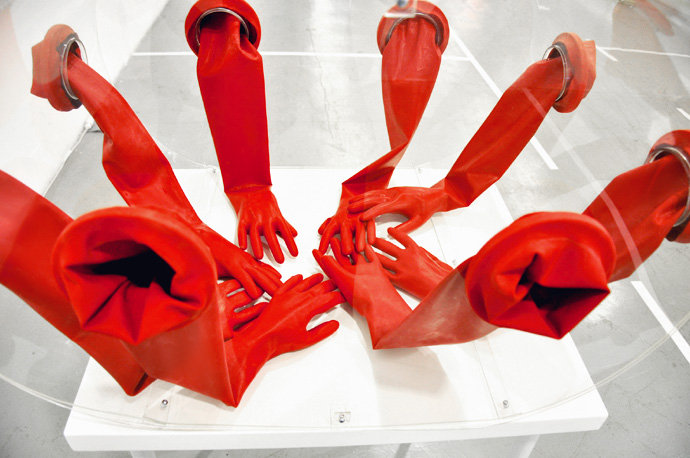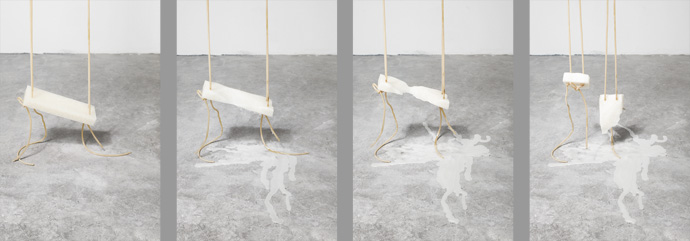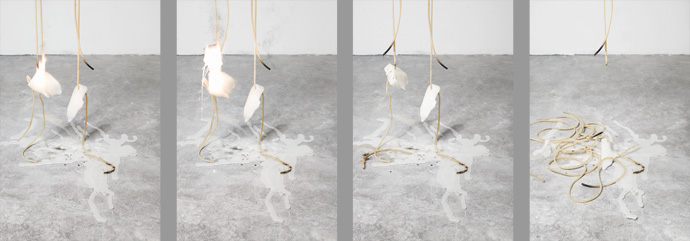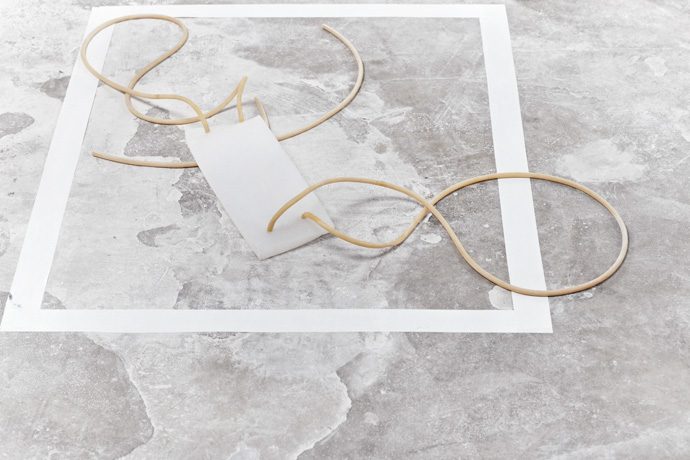-

HYERES 2013 EXPRESS 03 EXHIBITIONS
-Besides the photo and fashion competitions, one of the Hyères festival’s strongpoints are the original exhibitions it curates. Amongst this year’s shows, Lacoste designer and 2002 Hyères winner Felipe Oliveira Baptista, up and coming photo/video/grapher Pierre Debusschere, 2001 Hyères winner photographer Charles Fréger, and ROUGH PROOF, a look at the early works of Guy Bourdin with special pieces from the private collection of Marie Laure de Noailles… of course.
A THE STIMULEYE PRODUCTION
directed by Antoine Asseraf
filmed & edited by Thibault Della Gaspera
interviews Filep Motwary
coordination Clementine Colson
sound design Ça Va Chéri00 -

hyères express: felipe oliveira baptista
-“a screen to the brain” is what Felipe Oliveira Baptista wants to show us in Hyères.
Winning the Hyères award in 2002, then the ANDAM Award, “FOB”, as he is nicknamed, made himself a name showing in Paris over the last 10 years, and is now also the creative director of Lacoste.
As he prepares his return to Hyères, this time as Jury President, he faces the inquiries of our team of bloggers…
Felipe Oliveira Baptista by René Habermacher.
Filep Motwary: If I asked you to look back to the beginning of your career and compare how the industry worked then to how fashion functions today, what would you say are the biggest changes?Everything has speeded up a lot, more collections, pre-collections, collaborations & capsules. Internet gave way to a whole new way of spreeding new talent, ideas and concepts. it is a very different landscape from the beginning of the century. On the other end, we seem to live in an era where there is too much of everything and by the time something new is found, it is already finished.
Warhol’s 15 minutes have turned into 15 seconds.
Antoine Asseraf: Winning Hyères + Winning the ANDAM + Consulting for other brands… is that the only path for French-based designers to establish themselves today ?
I think Paris is the toughest fashion week for a youg designer. Between all the big houses and a strong presence of other international designers, it makes the spotlight smaller; so Hyeres & the Andam are a great help to get your name out there.As for working for other brands, if you are independent and do shows, it is almost mandatory.
Sean Santiago: How do you keep a sportswear brand such as Lacoste relevant on an international scale, and is international appeal vital for a successful brand? Where does that appeal come from – catering to diverse markets or maintaining a uniquely French aesthetic that people find desirable?Lacoste is relevant on an international scale with more than 1500 shops world wide. We create a base and main message through the show collections, pre- collections and advertising campaigns, but there are regional adaptations done to answer local needs.Bruno Capasso: You being Portuguese felt any difficulties to enter in the market, even though you have a British training? What do you think of Portuguese fashion today? Which are the things that need to be improved so they have more global approach?I don’t know…I do not think my nationality went for or against me, I believe individuality is stronger than one’s nationality.
Vogue.de: You are going to have an exhibition at Hyères as well. What are you going to display?“A screen to the brain” is an installation made of 100 different sized screens that go through the creative process of a collection: references, collages, drawings, videos to the pages of fashion magazines.
This installation will evolve and will be shown again in a FOB exhibition starting next october in MUDE, Lisbon. -

hyères just a taste… Olivier Saillard
-His name may not ring any bells, especially if you’ve never attended one of the numerous exhibitions he curated during his years at Union des Arts Décoratifs or more recently in his new position as curator for Paris’ Galliera Fashion Museum.But his appreciation, his judgement, informed by an impressive culture and understanding of fashion in the long run, leave little to doubt.Who better to evaluate the young talent of tomorrow than one of the few people who get fashion beyond the trends of the moment ?Days before his double Comme des Garçons / Balenciaga exhibit opens at Cité de la Mode, here is Olivier Saillard.Hyères 2012 jury member, Olivier Saillard, Director of the Galliera Fashion Museum. Photo by René Habermacher.
Why should a garment be considered as important?At the risk of appearing a bit primal, because we’d be a bit cold if we had to live naked, unless we all moved to warmer pastures !
Beyond climatic considerations, I love to see a garment as a solution, and to note that some designers are, to this day, still preoccupied by the idea of solving, through a way of dressing, our natural morning wardrobe.You have produced works that straddle the line between fashion and performance. Or maybe there is no line. When looking at the collections for the festival, how important is the element of presentation to you? Would a poor presentation of a great garment influence how you score it?Now more than ever, presentation interests me less than the garment itself. I skip fashion shows and rather appreciate presentations in show rooms.
(more…) -

Guy Bérubé and his Petite Mort
-It has been one year now since I moved to Ottawa, Canada. During the past year I’ve come across a few people who are always trying to make the city exciting. Guy Bérubé, a good friend now, is one of them. He owns a gallery – La Petite Mort, a place where taxidermy meets with iconic furniture pieces and fundraising art sales for several charities (including Guy’s own).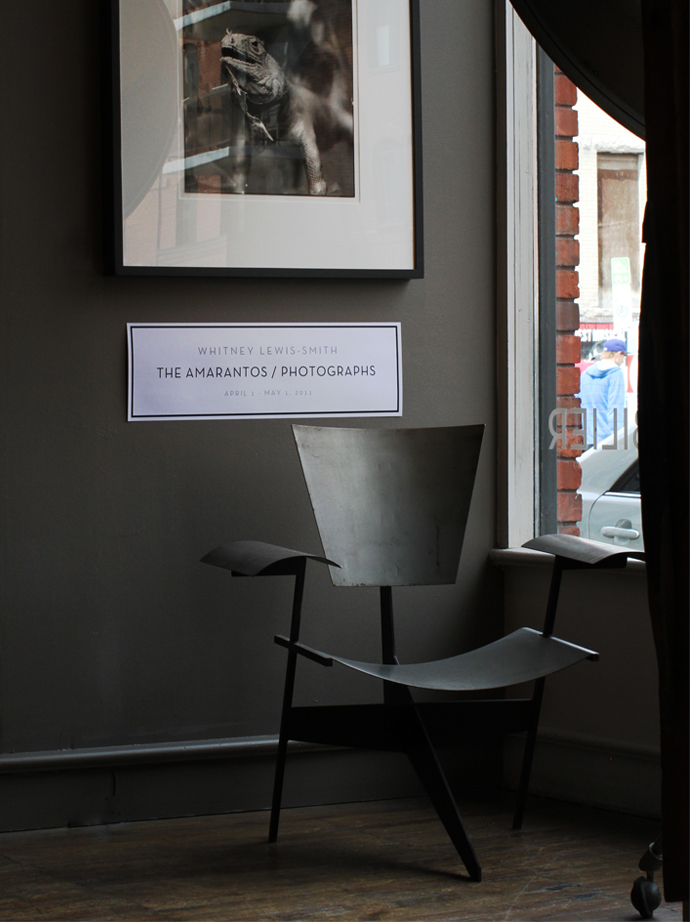 Lizard photo: Whitney Lewis-Smith.Far from presenting “Hockey art” or Canadian landscapes, in Guy’s gallery you will find work ranging from portraits of the city’s crack addicts by photographer Tony Fouhse, to poems on pieces of cardboard by Crazzy Dave of the Ottawa homeless community.With the look and fame of a bad boy, I can only say that Guy is doing a great job for the art community in Canada: making art available and affordable to whoever is interested.
Lizard photo: Whitney Lewis-Smith.Far from presenting “Hockey art” or Canadian landscapes, in Guy’s gallery you will find work ranging from portraits of the city’s crack addicts by photographer Tony Fouhse, to poems on pieces of cardboard by Crazzy Dave of the Ottawa homeless community.With the look and fame of a bad boy, I can only say that Guy is doing a great job for the art community in Canada: making art available and affordable to whoever is interested. Legs with severed head (Guy's head, btw) Peter Shmelzer.What was the last thing that stimulated you?It happened here in Ottawa, it happened to be a lesbian wedding performance by former American prostitute and porn star turned performance artist, Annie Sprinkle, and her partner, hosted by SAWGallery. It was very interesting for me to see. They are already married, but they do an annual wedding with a theme, and this time here in Ottawa it was marriage to nature, and marrying snow. They are eco-sexual; they have sexual feelings about nature (laughs). I hadn’t seen Annie Sprinkle in over 25 years, and I had met her before at a performance in NY where she had a live orgasm on stage.So, it happened next door to my gallery at St. Brigid’s (a deconsecrated Church), and a lot of people came, and they saw the look and the aesthetics of a wedding. Everybody wearing white, everything was beautifully decorated, the light was coming through the stained glass… but then the performance started. They rode a pile of snow, exposing themselves by lifting their wedding dresses, and then inserted icicles up their vaginas, as they recited their wedding vows.That seems a bit unusual for the city…I’m seeing change, slowly but surely, over the 10 years that I have been here. I know that I’ve had some credit for some of the change. I’m seeing a difference in the art that is featured in galleries, even the Municipal galleries are showing things from my artists. It is something positive; Ottawa is a city where there is a possibility of starting from scratch, even though you’ve seen it in other places. Ottawa is a funny little town, very voyeuristic; it’s like the dude at the orgy who complains about the bad drapes and doesn’t jump into the fun.What would be a good example of this change coming from your gallery and artists?
Legs with severed head (Guy's head, btw) Peter Shmelzer.What was the last thing that stimulated you?It happened here in Ottawa, it happened to be a lesbian wedding performance by former American prostitute and porn star turned performance artist, Annie Sprinkle, and her partner, hosted by SAWGallery. It was very interesting for me to see. They are already married, but they do an annual wedding with a theme, and this time here in Ottawa it was marriage to nature, and marrying snow. They are eco-sexual; they have sexual feelings about nature (laughs). I hadn’t seen Annie Sprinkle in over 25 years, and I had met her before at a performance in NY where she had a live orgasm on stage.So, it happened next door to my gallery at St. Brigid’s (a deconsecrated Church), and a lot of people came, and they saw the look and the aesthetics of a wedding. Everybody wearing white, everything was beautifully decorated, the light was coming through the stained glass… but then the performance started. They rode a pile of snow, exposing themselves by lifting their wedding dresses, and then inserted icicles up their vaginas, as they recited their wedding vows.That seems a bit unusual for the city…I’m seeing change, slowly but surely, over the 10 years that I have been here. I know that I’ve had some credit for some of the change. I’m seeing a difference in the art that is featured in galleries, even the Municipal galleries are showing things from my artists. It is something positive; Ottawa is a city where there is a possibility of starting from scratch, even though you’ve seen it in other places. Ottawa is a funny little town, very voyeuristic; it’s like the dude at the orgy who complains about the bad drapes and doesn’t jump into the fun.What would be a good example of this change coming from your gallery and artists?
The USER series by Tony Fouhse is a perfect example of what my gallery does, something of which I’m very proud. It was featured in New York Times, Japan Newsweek… people got it, but it was very difficult at the beginning; lots of people in the neighbourhood, politicians, people were very against the work. Men wrestling: Matthew Dayler / Photo of man laughing: Tony Fouhse.
Men wrestling: Matthew Dayler / Photo of man laughing: Tony Fouhse.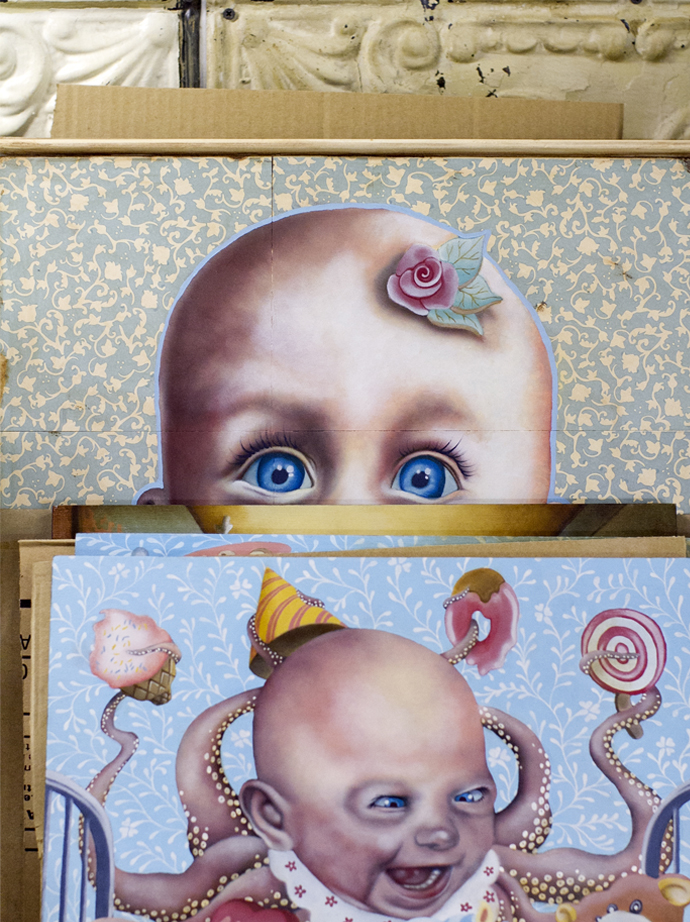 Creepy baby head: Robert Farmer.What’s the deal with the stuffed animals?Before I had the gallery I had the fake tortoiseshell lamp, which I bought in Paris, and then I bought, not knowing why, the baboon. I think I felt sorry for him, it was on the floor of a junk store and people were grossed out by it, so I paid $20. And so, when I got the gallery, a friend of mine asked me if I was going to bring the “creepy animals”. Then people just started bringing their stuffed animals to me, and it became a depository, kind of like an orphanage. You can bring your stuffed animal, but it needs to have a good valid story, like all the other animals there. I’m not online desperately looking for an owl! I don’t buy them.
Creepy baby head: Robert Farmer.What’s the deal with the stuffed animals?Before I had the gallery I had the fake tortoiseshell lamp, which I bought in Paris, and then I bought, not knowing why, the baboon. I think I felt sorry for him, it was on the floor of a junk store and people were grossed out by it, so I paid $20. And so, when I got the gallery, a friend of mine asked me if I was going to bring the “creepy animals”. Then people just started bringing their stuffed animals to me, and it became a depository, kind of like an orphanage. You can bring your stuffed animal, but it needs to have a good valid story, like all the other animals there. I’m not online desperately looking for an owl! I don’t buy them.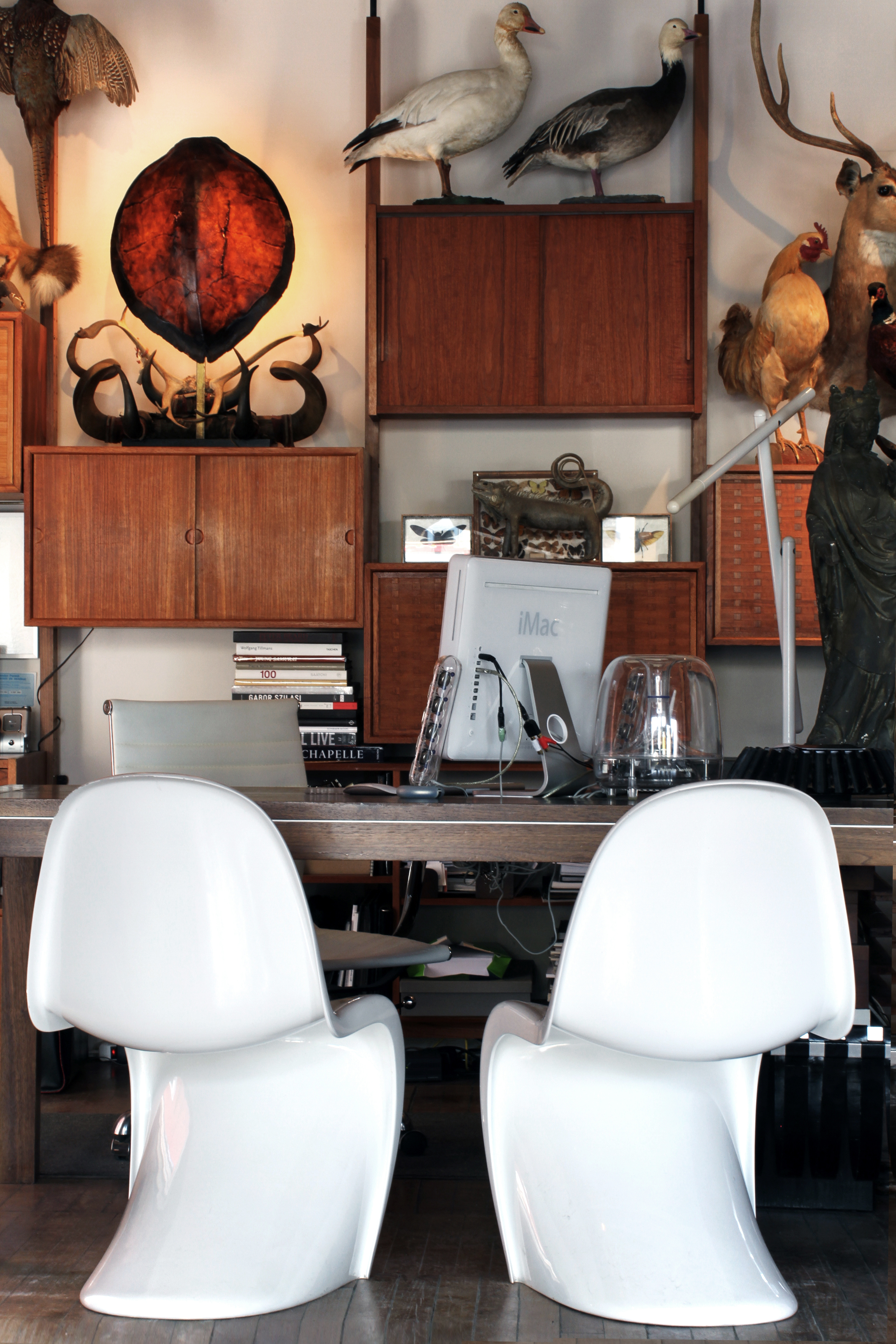
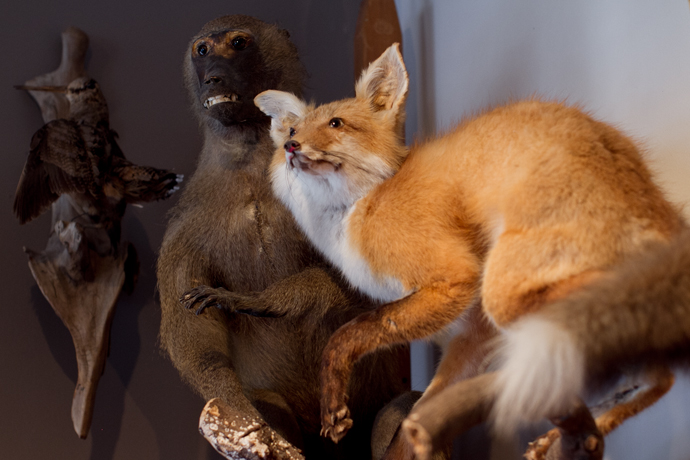 Guy's taxidermy collection.You must have some good stories…A woman once told me she wanted to give me a bison’s head, and I have always loved the look of them.So, we had a long conversation, and in the end she told me, “well, it hasn’t been taxidermied yet, it’s just the severed head” (laughs…) it was frozen!!!Make sure to check out La Petite MortSLAVA MOGUTIN & BRIAN KENNY
Guy's taxidermy collection.You must have some good stories…A woman once told me she wanted to give me a bison’s head, and I have always loved the look of them.So, we had a long conversation, and in the end she told me, “well, it hasn’t been taxidermied yet, it’s just the severed head” (laughs…) it was frozen!!!Make sure to check out La Petite MortSLAVA MOGUTIN & BRIAN KENNY
September 2 – October 2, 2011
INTERPENETRATION
Photographs & Drawings www.lapetitemortgallery.com -

MAX SCHELER: from Konrad A. to Jackie O.
-The exhibition “From Konrad A. to Jackie O.” at the Willy-Brandt Haus in Berlin will show for the first time a cross section of the work of Magnum photographer Max Scheler. On display throughout June and July are 140 images that document the distinct view of this artist who preferred to stay in the background. From this intimate eye-level position, he witnessed his time and documented its events with impeccable framing and allure.
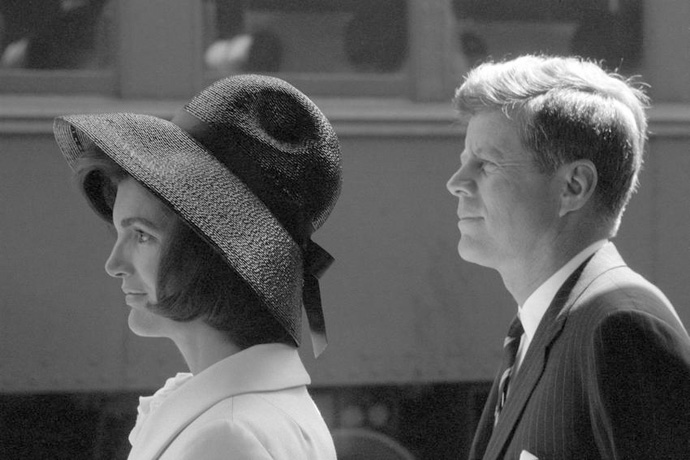 USA, 1963, Washington, John F. Kennedy and Jacqueline Bouvier Kennedy receive the Moroccan king Hassan II
© Max Scheler Estate, Hamburg Germany
USA, 1963, Washington, John F. Kennedy and Jacqueline Bouvier Kennedy receive the Moroccan king Hassan II
© Max Scheler Estate, Hamburg GermanyI remember Max Scheler with one of his beloved Davidoff cigarillos smoldering away nearby. He was an impressive character, with an elegant dryness that one would be tempted to account being Hamburgian, yet he was born a boy from Cologne. In his later years Max had dedicated his time entirely to taking care of the Herbert List estate – the iconic work of the photographer who shaped and mentored him. On one of my visits to the archives we went through folders and boxes of photographs and came so across prints of Max’ work for the first time, almost by accident. I had not been aware of his photography then, though i knew he had worked at Merian and founded the magazine GEO at Gruner & Jahr, introducing colour reportage to the wider audience.
I’ve talked with co-curator Olaf Richter, head of the estates of both Herbert List and Max Scheler about Max, his background and the relationship to Herbert List and the current exhibition
RENÉ HABERMACHER: How did this exhibition come together- and why right now?
PEER-OLAF RICHTER: The idea of this show was born in February 2003 – the month Max Scheler died. It took us about 6 years to finish this project. Why did it take so long? Max Scheler was humble if not neglecting his own work. He stopped working as a photographer in 1975 and since then had turned the tables. He rather worked to publish other photographers work, than his own.I took quite a bit of effort to rediscover what was going on in his life as a photographer. The negatives from the late 50s until the mid 70s were in a rough chronological order, but before that, the first 8 years, were all over the place. For us the first period was especially interesting, because it told us something of where he was coming from. He learnt photography from another photographer: Herbert List.
Herbert List printed the images that he considered important. The Estate had a rich base of vintage prints that covered all the projects he worked on in his life time. These prints were frequently titled on the back. The main books on List that had been on the market had all been made with these prints as a basis.
For Max Scheler things are very different. There is not that much vintage material, and it is hard to say if these old images reflect his personal choice or some editors preference. So we went back to the negative and contacts and researched there. Unfortunately the negative have only a rough labelling, and therefore it took a lot longer to make a selection, research locations and titles.
Max would always put Herbert’s work ahead of his own – which was something that I never understood. Why this hesitation?
I guess he felt that his work of that period, was the work of a pupil, while the work of his teacher, was really what was worth remembering. It is interesting how close the two worked together. After an initial year or two as an assistant on the road and in the darkroom, Scheler started getting his own assignments, gained some respect, moved from Munich to Paris, met Robert Capa and even became a junior member of Magnum.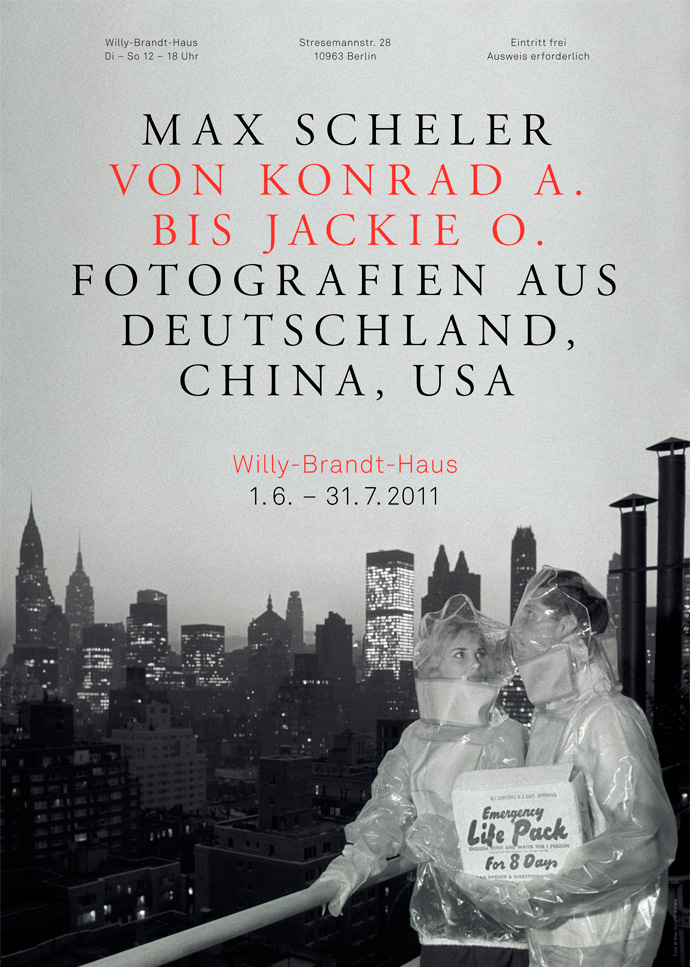
How did the relationship of the two evolve after the first meeting during war in Munich: personally and professionally? I am also asking that as I have a special interest in the idea of the “stimulating” mentor.
I guess stimulation needs at least to prerequisites. At first the receiver of the stimulus needs to be in a situation of wanting to open up, receive a certain change in her/his perception and possibly even her/his life. And the stimulus must also be desireable and fit the pattern of interest of the receiver. If the stimulus is too foreign or threatening it might be rejected. I think these things fell in place when Max Scheler met Herbert List.He was very young then- it must have been the shaping experience…
Max and his mother left Cologne in 1941, when Max was 13 or 14 years of age. Around the same time List left Athens, because Germany invaded Greece. He had tried to immigrate to the USA but failed and had to return to Germany. Max was raised without a father, since he died the year Max was born. The sudden presence of a male person of authority in the life of Max and his mother was quite welcome. Not to be misunderstood all three of them were very liberal, unconventional and forward thinking persons. None of them wanted to construct a classical family. It was more the realisation of his mother that this very sophisticated photographer in his forties did spark some certain interest and outlook in the young max’ life, that she possibly could not, because the was too close. She of course realized that he was gay and therefore no husband material. But she might have also understood that the conventional reaction of a mother to not allow her son to have contact to a 25 years-older gay man, would have been rather short-sighted.
So through the turmoil of the war they kept close contact.
The stimulation we talked about earlier, that caused Max Scheler to learn a craft, languages and a certain ‘savoir vivre’ from Herbert List, developed through that time.
And I think that it was manyfold. I am not sure if photography was really the most potent influence here. And I am not sure what was going on between the two of them emotionally. Did they fall in love? That is speculation, but I guess it safe to say that a certain amount of love and trust is necessary to allow oneself to be stimulated.
(more…) -

MAREUNROL’S
-Mārīte Mastiņa and Rolands Pēterkops, the minds behind fashion brand MAREUNROL’S pulled their strings for the installation TENANTS which just closed at the Villa Noailles in Hyères, France. The Latvian duo from Riga had already won the two biggest prizes at the Hyères fashion festival in 2009, made a stunning return fashion show in 2010, but his year’s exhibition proves not only their virtuosity in fabricating elegant and wearable pieces of clothing, but also their ability to create a much broader, often dark and poetic universe.
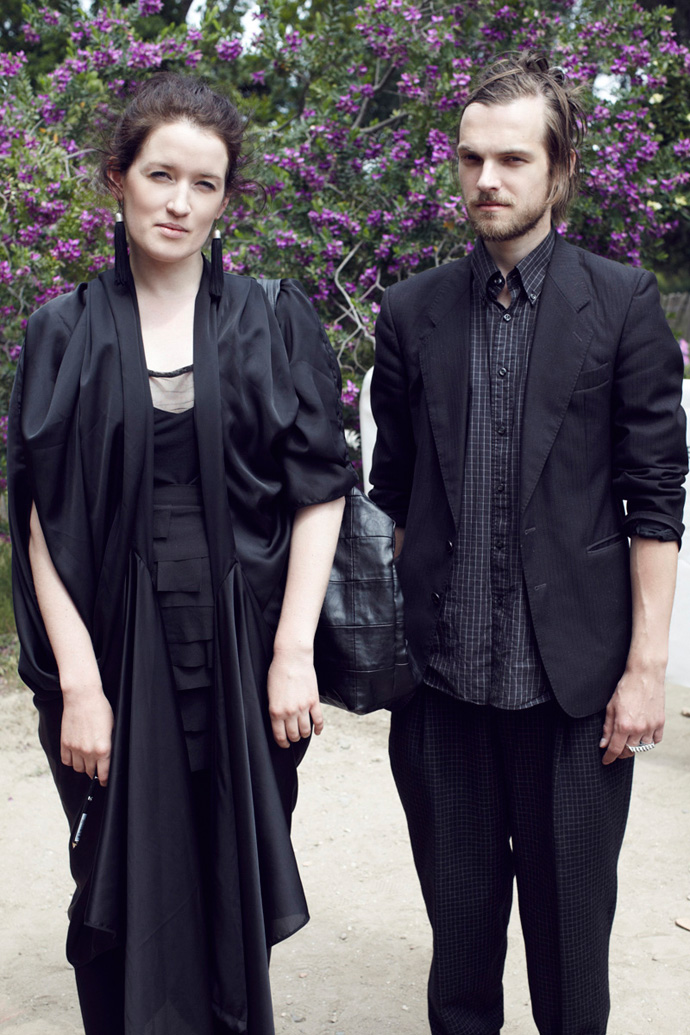 Mareunrol: Mārīte Mastiņa and Rolands Pēterkops at the garden of the villa Noailles.
Mareunrol: Mārīte Mastiņa and Rolands Pēterkops at the garden of the villa Noailles.RENÉ HABERMACHER: what was the point of departure for this installation and the inspiration behind it?
ROLANDS PETERKOPS & MARITE MASTINA: When we start to work on a new collection, we always make the designs first to fit on miniature mannequins. And each time we both have discussed the idea of beautiful dolls as models so we could our ideas of garments to shoot as small style photos and to show them as the newest collection. That is why this idea came naturally.The advantage of the small scale is that we have the freedom of implement anything, all our ideas without leaving out any of those costing an absolute fortune to make. Visual inspiration came in recent years moving from one apartment to another. That’s why our project is called TENANTS. As any of our works, this work also reflects our experience.
The inspiration for the installation came from artists’ constant moving from one apartment to another, from one neighbors to others, from one room to next and due to moving to new environment always makes you get used to new mystical noises, strange objects, loud or too quiet neighbors and other peculiarities connected with the apartment. But of course, with time you get used to all that. However, that all provoked thinking of how space influences those living in it and vice versa, and whether all these things in one way or another influence people and whether one imperceptibly starts to change, and whether this oddity is just in one’s mind, not reality. This is how emerged the idea for the installation with people/ tenants who dwell in their apartments and become as one with it. All their belongings are like a huge enormous shell/ attire which tell all their peculiarities, interests, specific hobbies and many other things.
These stories are made as small installations which show short sketches from character’s daily life. They communicate through costumes, scenography, sound and light. It is important that not only costumes and puppets are made for the installation, but also environment/ scenography, where they can express themselves and show the intended story, by forming a figurative composition which is combined with a surreal fantasy, mystique and a pinch of wit.
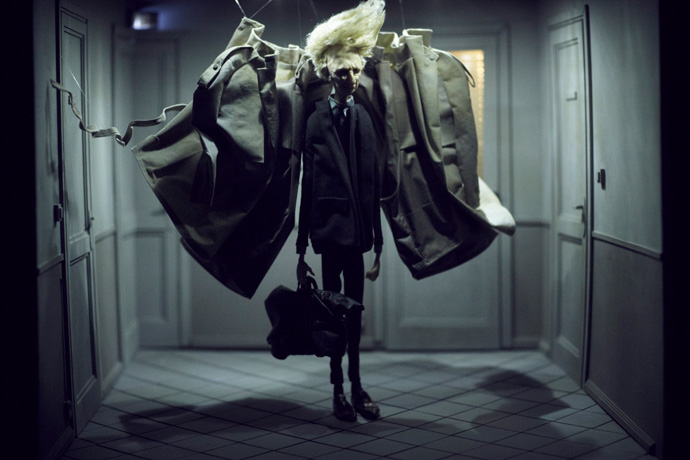 Mārīte Mastiņa and Rolands Pēterkops: Tableau from the exhibition TENANTS.
The dolls character is inspired and modeled after Keith Richards.
Mārīte Mastiņa and Rolands Pēterkops: Tableau from the exhibition TENANTS.
The dolls character is inspired and modeled after Keith Richards.Can you explain me the process of planning and making the installations?
First we had a few visions of the project, then we started working on sketches slowly crystallyzing the characters. At the same time we started looking for people who could make the puppets we had envisaged. It was really important for us to find a puppet master who could make the dolls with movable head and arms. It is really important for our Prague project.
(more…) -

SAVE TOKYO CREATION
-This week, under the helm of curator Takafumi Kawasaki, 18 hot Japanese fashion brands and 10 photographers team up in Tokyo for SAVE TOKYO CREATION. As the official Tokyo fashion week was cancelled due to the recent events, stylist Takafumi Kawasaki initiated this show to give young designers an opportunity showing their collections from May 27th to 29th at EYE OF GYRE, Omotesando, Tokyo. Accompanying the show, artworks by Tokyo Posse ENLIGHTMENT will be on display, and a fanzine produced.
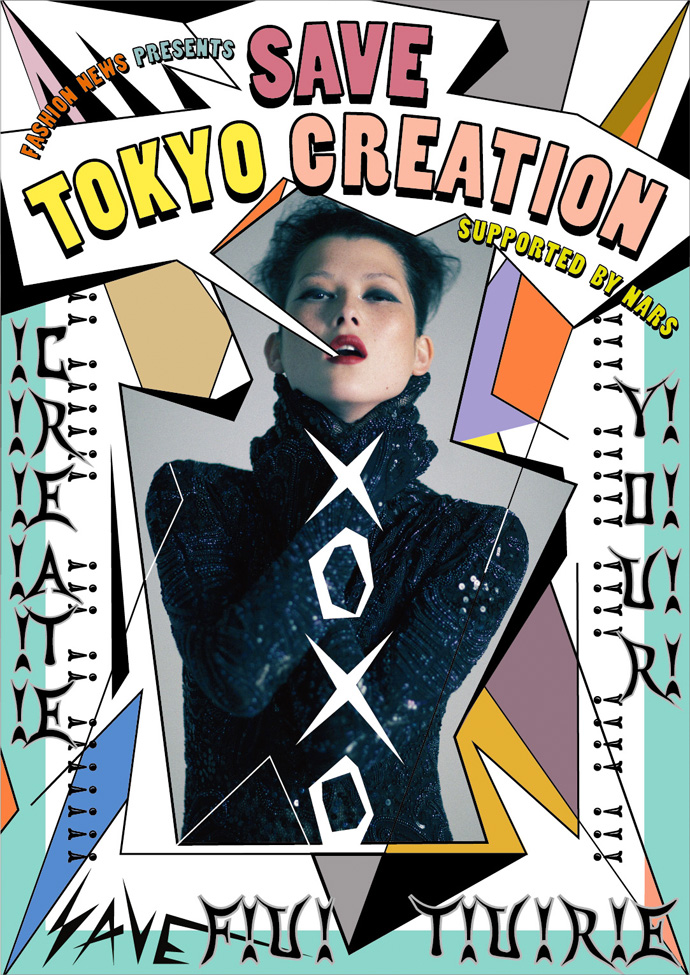
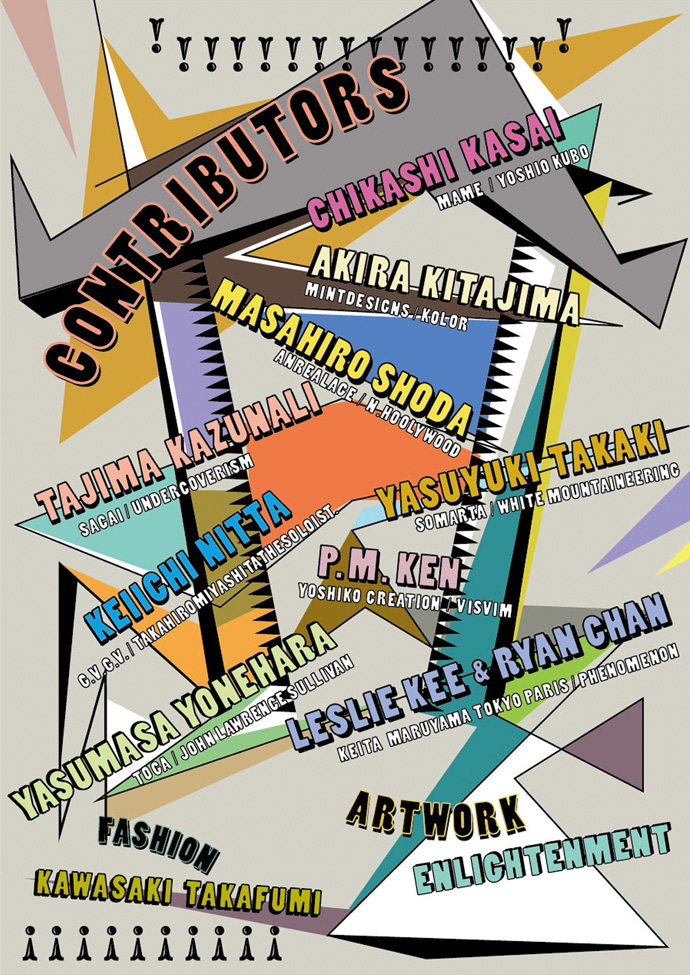 Poster of SAVE TOKYO CREATION by ENLIGHTMENT. Photography by Yasuyuki Takaki
Poster of SAVE TOKYO CREATION by ENLIGHTMENT. Photography by Yasuyuki TakakiThe 18 designers produced special pieces for the project to be auctioned for donation. Among the designers showing, is much beloved Jun Takahashi for UNDERCOVER, YOSHIKO CREATION, famous for her unique pieces to Lady Gaga, TOGA, N.HOOLYWOOD and emerging designer JOHN LAWRENCE SULLIVAN, among others as ANREALAGE, G.V.G.V., KEITA MARUYAMA TOKYO PARIS, MAME, MINTDESIGNS, SACAI, SOMARTA, KOLOR, PHENOMENON, TAKAHIROMIYASHITATHESOLOIST, ISVIM, WHITE MOUNTAINEERING and YOSHIO KUBO.
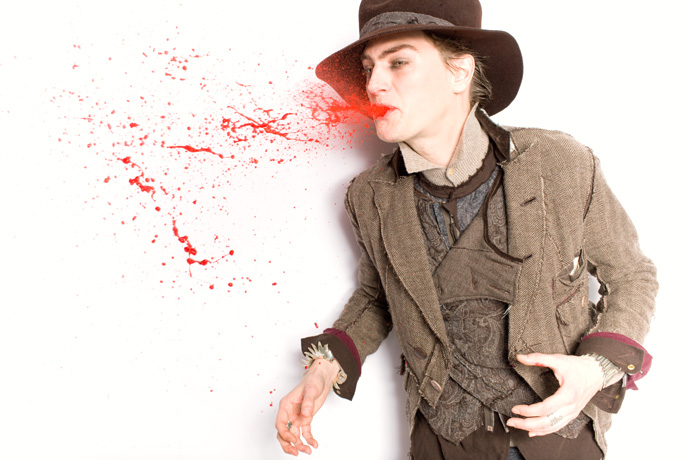 SAVE TOKYO CREATION Photography by Keiichi Nitta
SAVE TOKYO CREATION Photography by Keiichi NittaThe designers AW 2010 designs were picked up by Photographers and lensed especially for that show: Akira Kitajima, Chikashi Kasai, Tajima Kazunali, Keiichi Nitta, Leslie Kee & Ryan Chan, Masahiro Shoda, By P.M. Ken, Yasumasa Yonehara and Yasuyuki Takaki.
The Stimuleye spoke with Takafumi Kawasaki
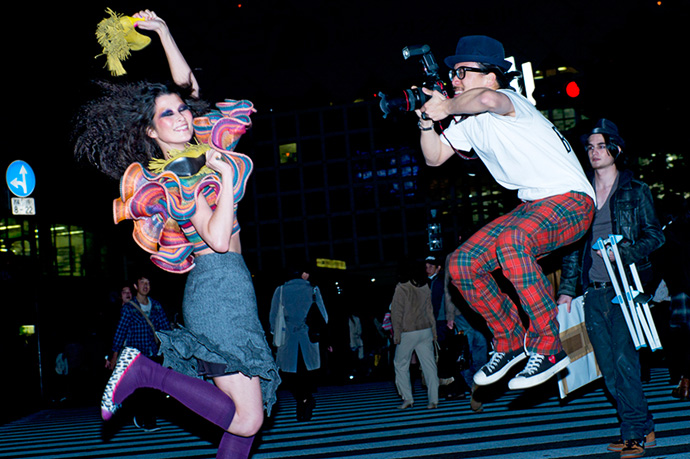 SAVE TOKYO CREATION Photography by Leslie Kee & Ryan Chan
SAVE TOKYO CREATION Photography by Leslie Kee & Ryan ChanRENÉ HABERMACHER: What was your intention with this exhibit?
TAKAFUMI KAWASAKI: SAVE TOKYO CREATION supported by NARS is a big feature of Japanese fashion designers, most of whom lost a chance to exhibit their 2011AW collection because of the earthquake impact.
It’s a charity but not a money-donated oriented.
I wanted to provide Japanese fashion designers a chance to show their 2011AW collection that could not be shown on catwalk because of the earthquake.
As a fashion director & stylist, I believe it is a form of charity that only I can produce to provide those designers with the opportunity to present their creation in public.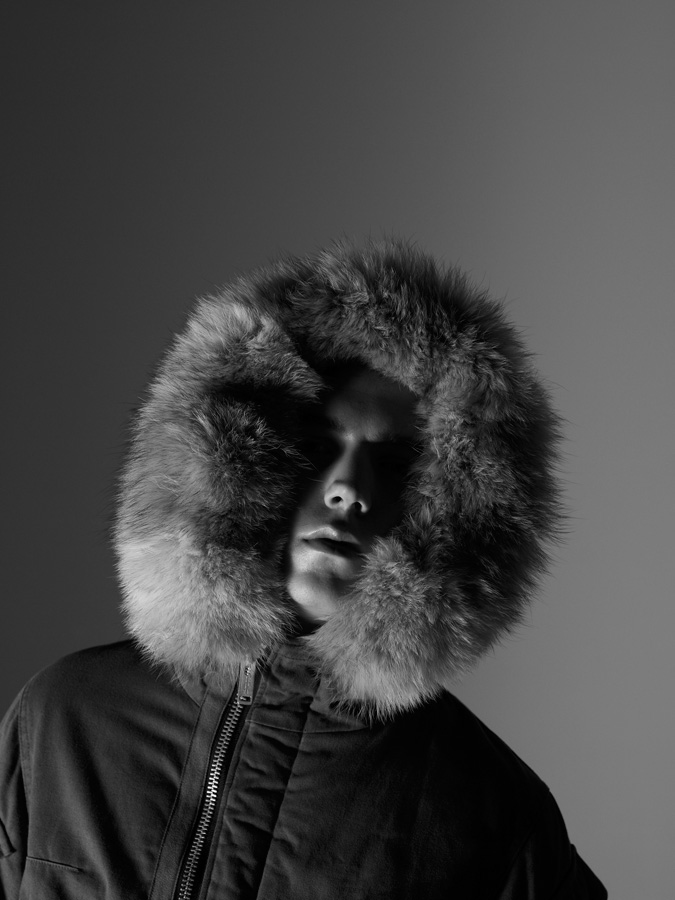
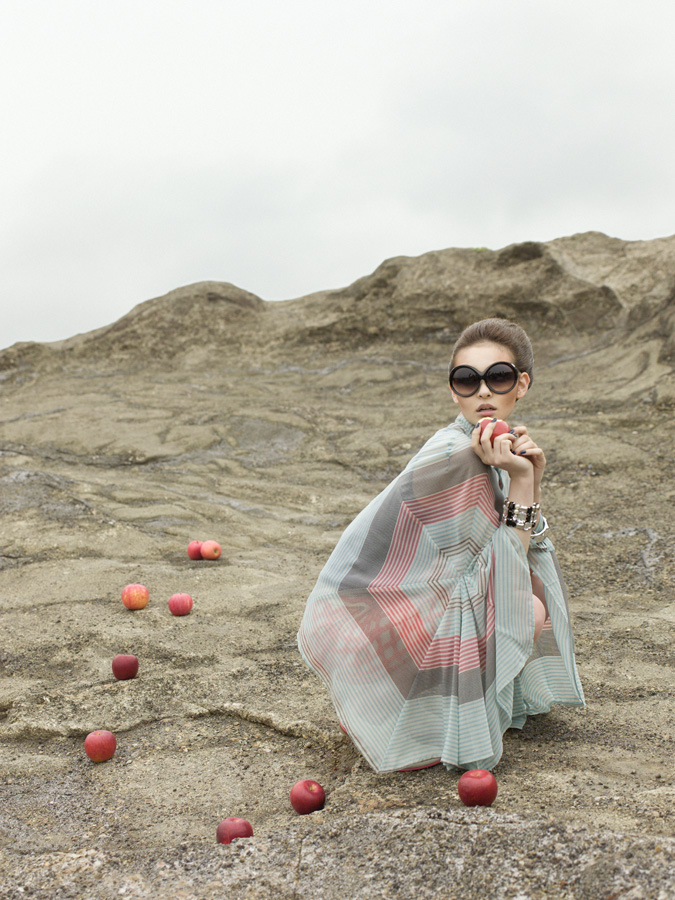 SAVE TOKYO CREATION Left: Photography by Kazunali Tajima. Right: Akira Kitajimat
SAVE TOKYO CREATION Left: Photography by Kazunali Tajima. Right: Akira KitajimatHow did the earthquake and its aftermath affect you personally?
The earthquake made me find the huge scepticism about Japanese government and the power of citizens. I would say I feel my approach to fashion and my styling works became more clearer and straight forward.
It may sound a little funny but I became more optimistic about the life. What already happened, happened, even if it’s a massive tragedy, there is no way to change or dismiss it. I feel there is no point to keep crying over that. But what we should do now, is to step forward.
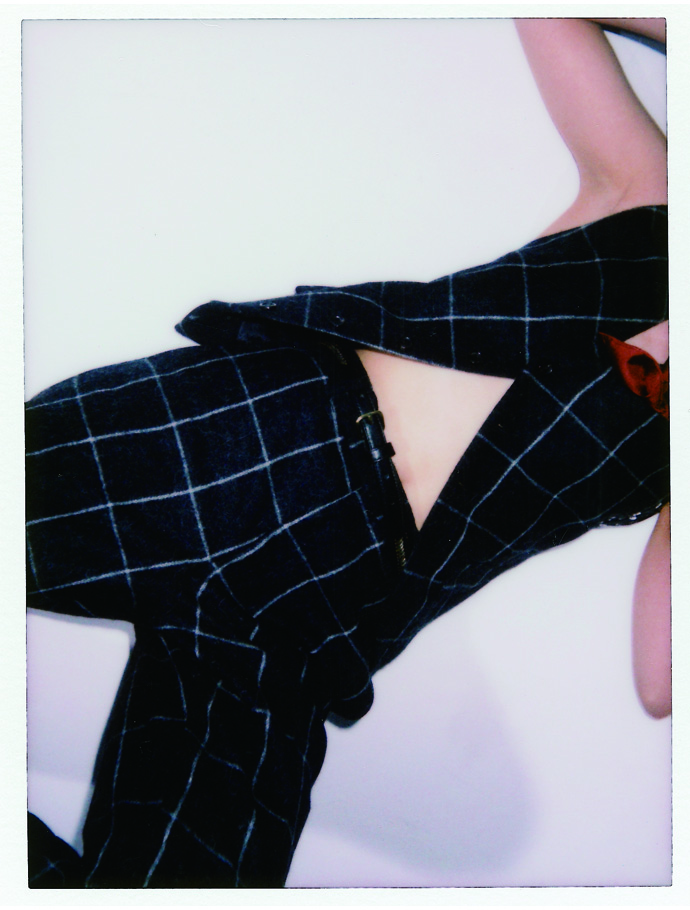
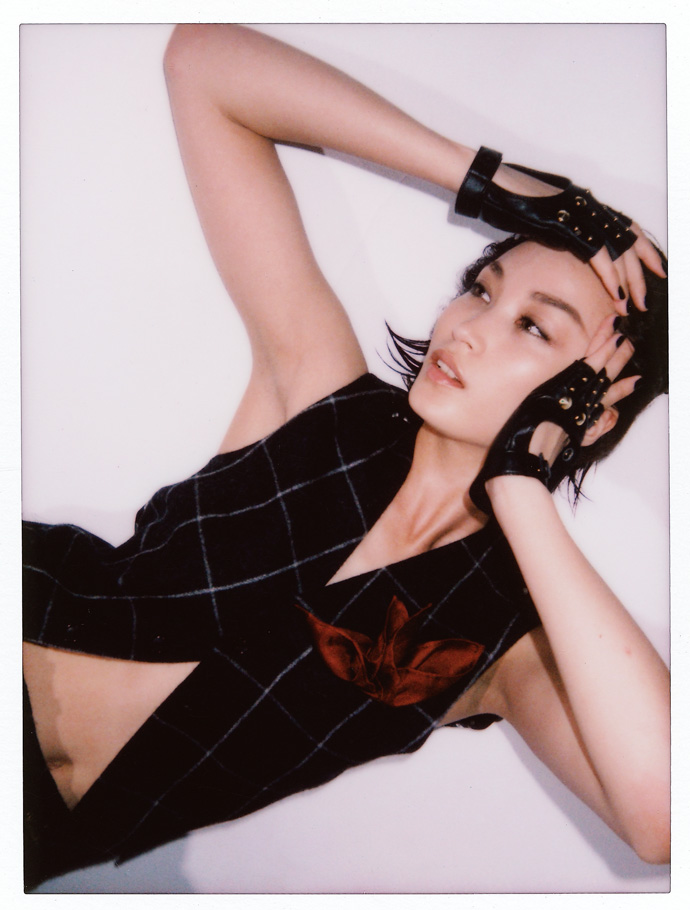 SAVE TOKYO CREATION Photography by Yasumasa Yonehara
SAVE TOKYO CREATION Photography by Yasumasa YoneharaDo you feel there is a different mood now among japanese society? I am asking as Japanese people expressing in the past to feeling alienated to their fellow countrymen…
Yes, “alienation” is a serious issue after the quake. Japanese people appear to be longing for the tightly-bound feeling.
Not only real communication and society, but also they are keen to make bonds with others in virtual community, such as Facebook, Twitter and other numerous social media networks. Some people are obsessed about that too much.Generally speaking, however, I think the Japanese people have found what is important and what is less in life. I believe this is a great chance to reform the typical Japanese convenience-oriented life.They appear to have started making their lives a little slower and calmer, too.
It’s really a big shift of the country.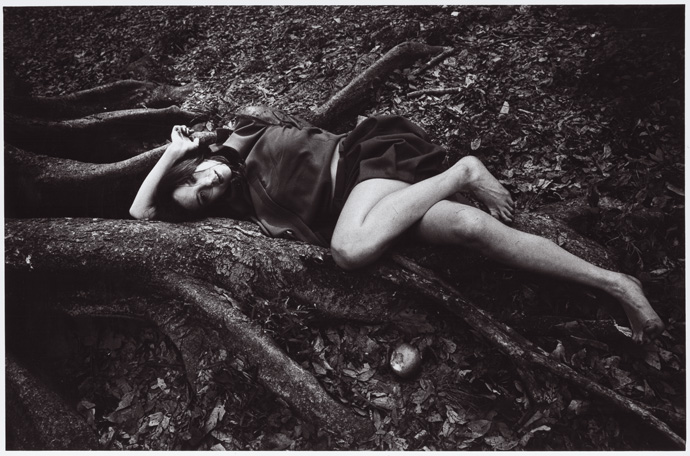 SAVE TOKYO CREATION Photography by Chikashi Kasai
SAVE TOKYO CREATION Photography by Chikashi KasaiWhat is the last thing that stimulated you?
I would say THE EARTHQUAKE in Japan.The exhibition is held from May 27th to 29th at EYE OF GYRE, Omotesando, Tokyo.
 SAVE TOKYO CREATION Photography by Masahiro Shoda
SAVE TOKYO CREATION Photography by Masahiro Shoda -

SANDRA BACKLUND: is knitting herself to the top
-Wherever Sandra Backlund picks her thread it will lead to an incomparable result. That earned her the jury prize in Hyères 2008 and with it international recognition, on which Louis Vuitton had bought in shortly after. The dark Swede impresses with knit works that go far beyond the discipline of fashion and render the use of traditional artisan technique to visionary, body oriented sculptures. Looking at her latest installation CUPRUM 2010, it comes not as a surprise she had studied art history.
The Piece made entirely of finest copper yarn, was commissioned by the Villa Noailles for this years exhibition.The Stimuleye talked with Sandra about here recent work. The conversation was shortly interrupted by yet another request from the international glitteratti circuit: Sandra is truly knitting to the top!
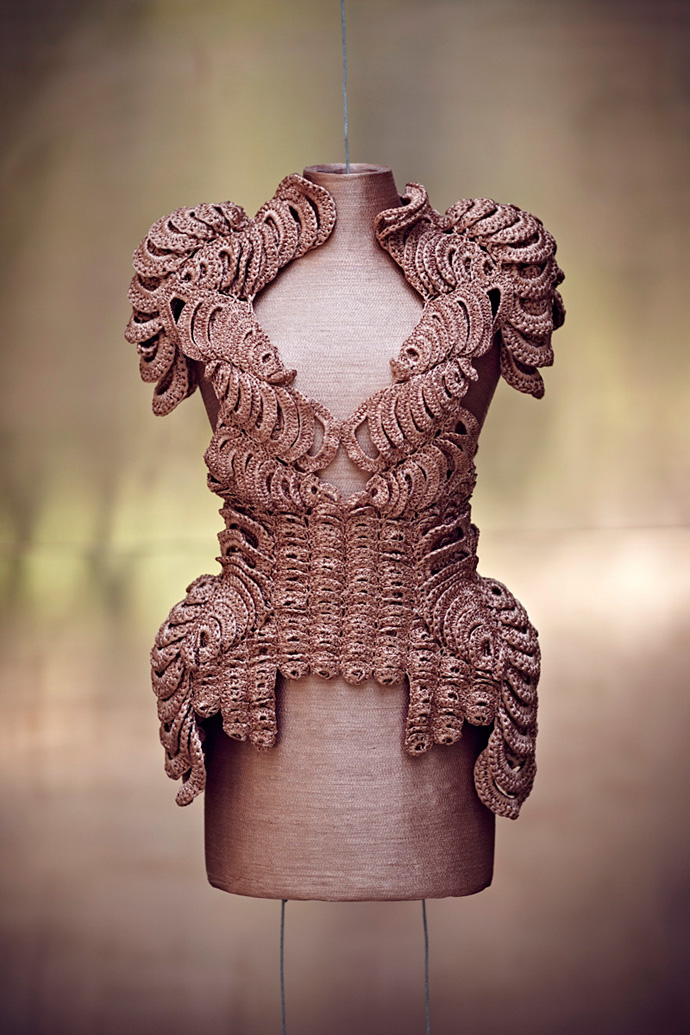 Sandra Backlund's installation CUPRUM 2010 at the Villa Noailles' pigeonnier. Photography by René Habermacher
Sandra Backlund's installation CUPRUM 2010 at the Villa Noailles' pigeonnier. Photography by René HabermacherRENÉ HABERMACHER: What was the point of departure for this installation and the inspiration behind it?
SANDRA BACKLUND: Everything took off from the position they gave me for my exhibition, the Pigeon House in the north garden of Villa Noailles. I think it’s a very beautiful space, so I wanted to use it as a frame, rather then just a location. Because the house is partly open and the exhibition would run for one month outside, I had to carefully consider what material to work with. Already for my current S/S 2011 collection I had been working with a metal yarn made from 100% copper, so in a way it came natural to me to continue exploring that material. With a history of use that is at least 10 000 years old, copper is an important part of both our history and the future. It’s one of the world’s most useful natural resources, 100% recyclable without any loss of quality and it’s estimated that 80% of the copper ever mined, is still in use today. In a way I feel like the story of copper as a material and the way I try to approach fashion go very well together.Can you explain me the process of planning, and the making of the dress?
As always, the handicraft techniques and the human body is the main starting point for me. I never sketch, instead I work with a three dimensional collage method where I develop some basic bricks that I multiply and attach to each other in different ways to discover the silhouette. The only thing I decided already from the beginning was that I wanted some kind of link between the signature piece (the paper origami top) of my winning collection from the 22nd edition of the festival in 2007. Because of the different techniques, materials and colours and because of the process, I guess in the end the link is not so obvious, but there is a few things that is still noticeable, like the silhouette and the size gradings for example.I’ve witnessed you working day and night on this piece – do you have a clue how many hours went into the making?
To be honest, I think that this is the longest piece I have ever worked on. First of all, crochet is always extremely time consuming, especially when it’s layered like this. The copper tape is also very fragile and ones it’s used it, it’s impossible to change, so I had let go of the control and in a way let faith guide me to the end result. If we are talking hours, my estimation is around 500-600 hours.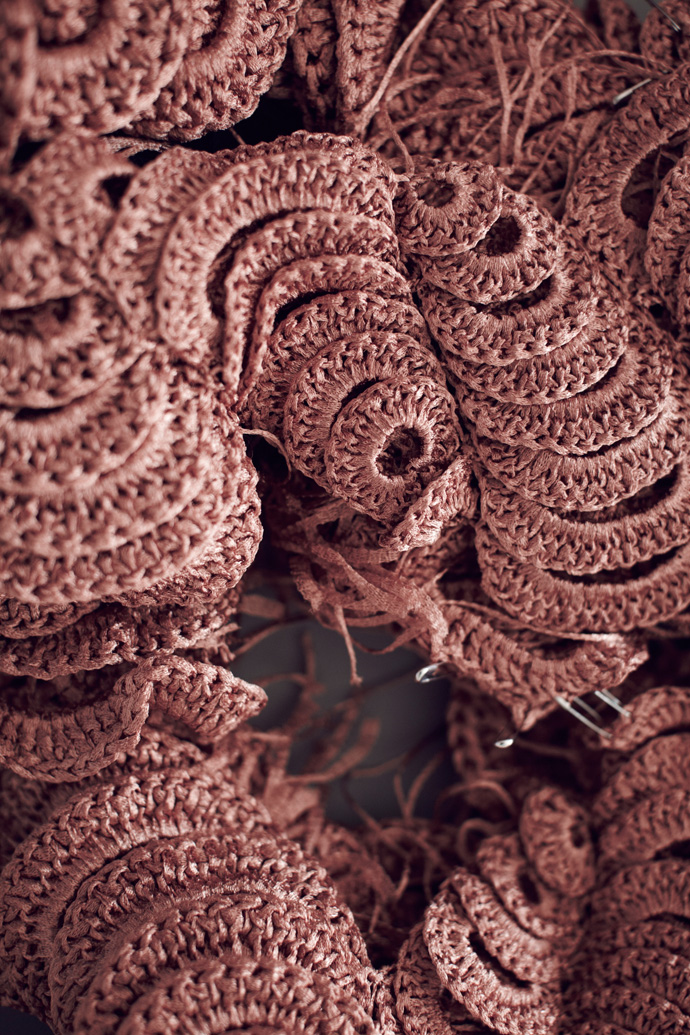
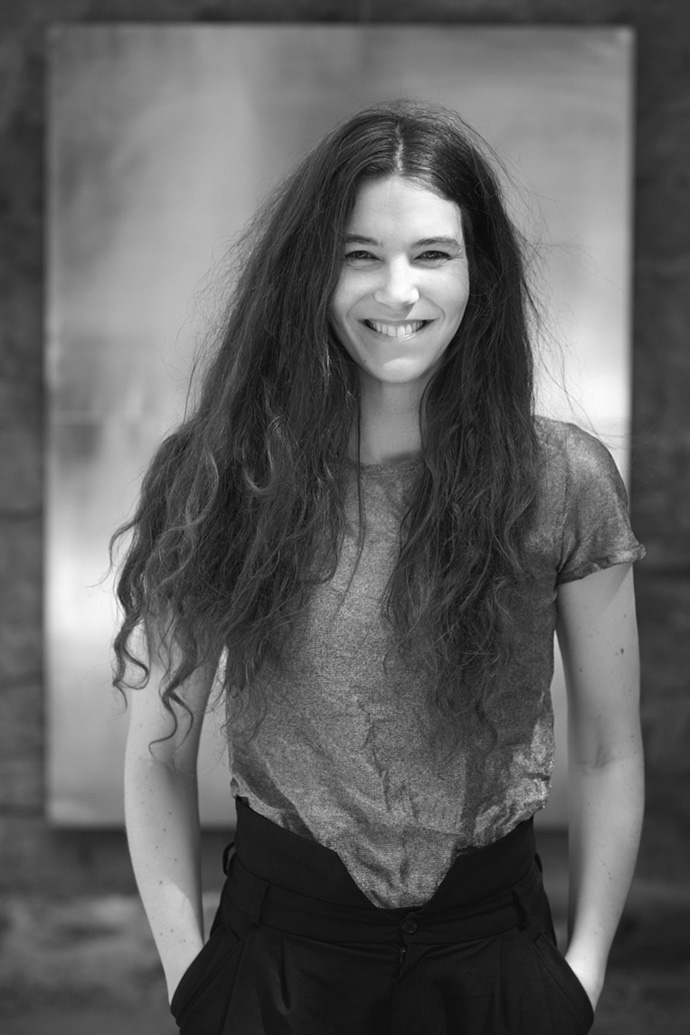 Pieces of copper yarn in the the making, and Sandra at the exhibition space. Photography by René Habermacher
Pieces of copper yarn in the the making, and Sandra at the exhibition space. Photography by René HabermacherYour pieces are often very sculptural, with the artisan work involved, i wonder wether you consider to put your work in a different context than fashion?
Of course I have consider this and many times questioned if fashion is really the right context for my work. As you said, my clothes are always quite sculptural and I also use methods when working that is more close to a sculptor’s, then a tailor’s. But somehow I always come back to the human body. I like to consciously dress and undress different parts of the body and I am very fascinated by all the ways highlight, distort and transform the natural silhouette with clothes and accessories. For me fashion is also one of the most democratic art forms, something that we are all related to. You don’t have to be a designer or a stylist to use clothes as a creative statement, but people in general could of course be more self-governed when t comes to fashion.To me it seems difficult to render your unique approach into industrial production. How are your experiences with that?
About two years ago I was introduced to the long tradition of Italian top knitwear and apparel production. The challenge was to add to my collections something inspired by my hand made pieces that could require only a limited amount of manual work. It was of course a big step for me to go from working alone in my studio, inventing pieces while doing them myself by hand, to suddenly be working in a team of experts within a field of fashion that I never before have had the chance to get to know. I was overwhelmed by all the possibilities I saw and even though I will never give up doing my hand knitted signature pieces, these production tests really made me understand that there is ways to develop my collections that I never thought was possible.What is this festival of Hyères to you? How was it to win – and to be back for this project?
The whole event is really an experience for life when you’re a young designer, all the people you meet and the rush from showing your work in a context like that. I didn’t know about the festival before I met Diane Pernet and she suggested that I should apply. I was crazy happy already when I was selected for the finale and then the wind up… It’s really an important moment in my career so far and to be back again this year and meet everyone was kind of a flash back. When I think about it, I’m still a bit shocked that I was the winner.What’s up next?
F/W 2011-2012 production, S/S 2012 collection and some up coming exhibitions.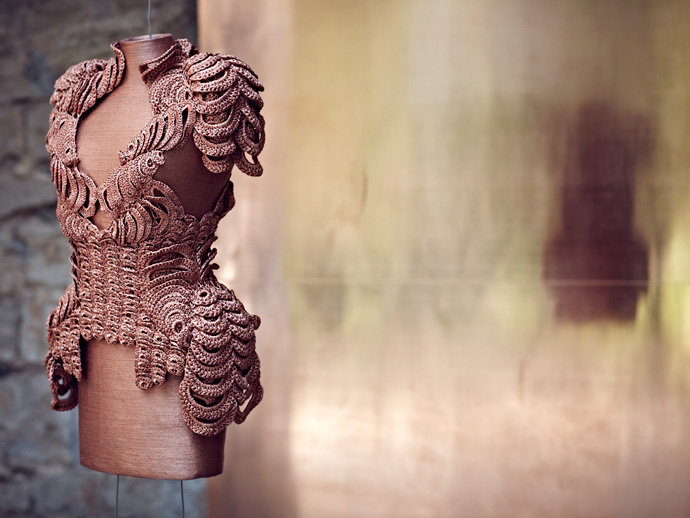
The dress weights over 6kg, made from an archaic material that was the first to be 100% recyclableFurther information on Sandra Backlund: sandrabacklund.com
The Exhibition at the Villa Noailles in Hyeres runs throughout May until the 29th -

MATT PYKE AND FRIENDS: that idea of foreverness
-The future is back.
That’s the impression you get from Matt Pyke’s new show at Gaîté Lyrique, Paris’ brand new digital creation center. Mutating monsters, illuminated silences, evolving creatures, disintegrating dancers, glowing trees… Pyke and his friends from the studio Universal Everything use every corner of new-old parisian theater to make your head swirl. Literally.
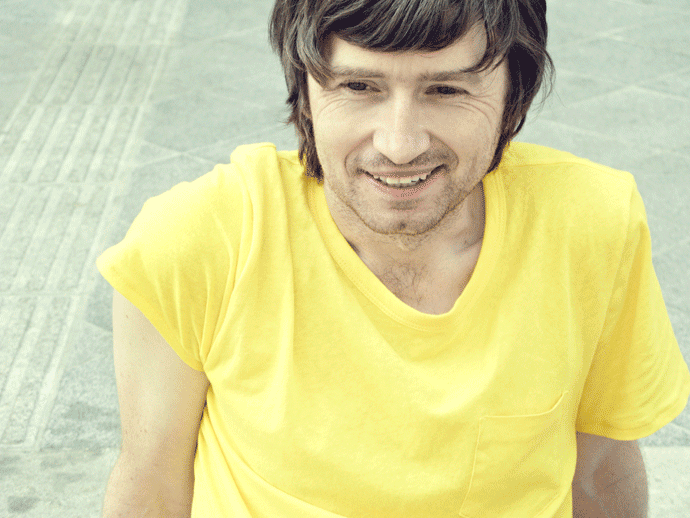 Meet Matt Pyke. Photo by René Habermacher
Meet Matt Pyke. Photo by René HabermacherANTOINE ASSERAF: I noticed everything is looping, there is no beginning and no end. What as your intention with that?
MATT PYKE: One of the reasons for the looping is we’re really interested in the idea of infinity and how it creates video artworks which don’t really have a narrative story to them.
We’re creating almost a video sculpture, a state of mind or a trance-like situation: for example where dancers that are continually struggling up the wall to get to the sound or the giant walking monster in TRANSFIGURATION which is walking forever and nobody knows where he is going.
It’s that idea of foreverness and how you can use video to do that as an artwork that never stops: everything is almost like a machine that is going and going…
Matt Pyke & Friends : Super-Computer-Romantics
Sometimes you have some very un-digital elements like drawing.
I studied drawing and painting at art school and still find it very important to have a pencil as well as a computer. All of the artworks were based on drawings originally. The archive of the Gaîté Lyrique has a collection with all the working drawings from all the artpieces.
In the exhibition, the one called SEVENTY SIX SEEDS was entirely created through drawing but influenced by the more recent years where i’ve been working with people who use codes. The drawings are very much influenced by digital processes and the shapes that code make.
We’ve made an iPhone application that gave me kind of genetic instructions of what type of seed what type of plant to draw every morning- so it’s a way of using technology to control me, control my pencil.
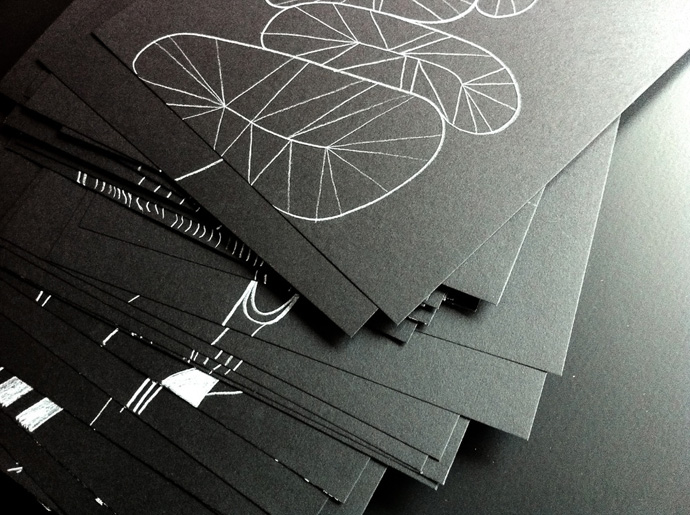
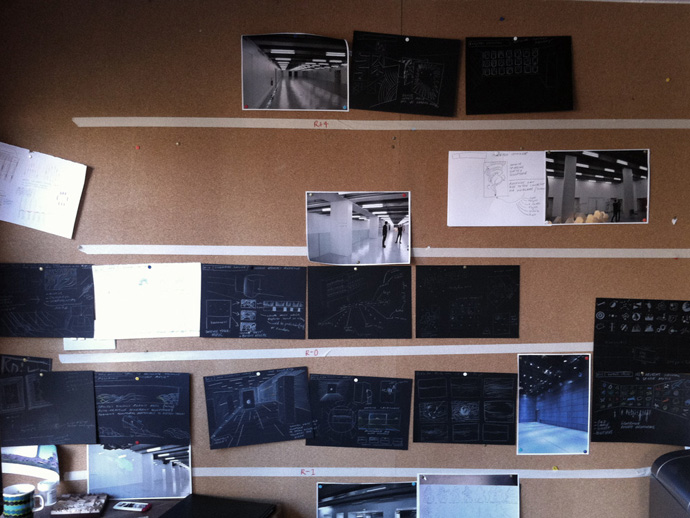 Works in Progress: left Matt Pykes drawings for SEVENTY SIX SEEDS inspired after an iPhone application.
Images Courtesy of Matt Pyke
Works in Progress: left Matt Pykes drawings for SEVENTY SIX SEEDS inspired after an iPhone application.
Images Courtesy of Matt PykeDo you code and program yourself or are you trying to bring that kind of “old school” thinking into that?
I intentionally do not code and program myself. I tried to learn and found it did not suit me, so I focus on the conceptual side of things and the visual side of things in terms of art direction and creative direction and come up with the initial seed idea and then work with programmers who are genuinely experts or super talent in their field.
I think one important thing is, by me not understanding code, that my ideas are not restricted to what is possible.
-

Not all fun and games : Abdel Bounane
-Last month, the Gaïté Lyrique digital creation center opened its doors in Paris, after many years of construction.
A companion shop also opened next to the gorgeous building : the AMUSEMENT creative shop.
We sat down with Abdel Bounane, who is in charge of the store but also the founder and editor-in-chief of AMUSEMENT magazine.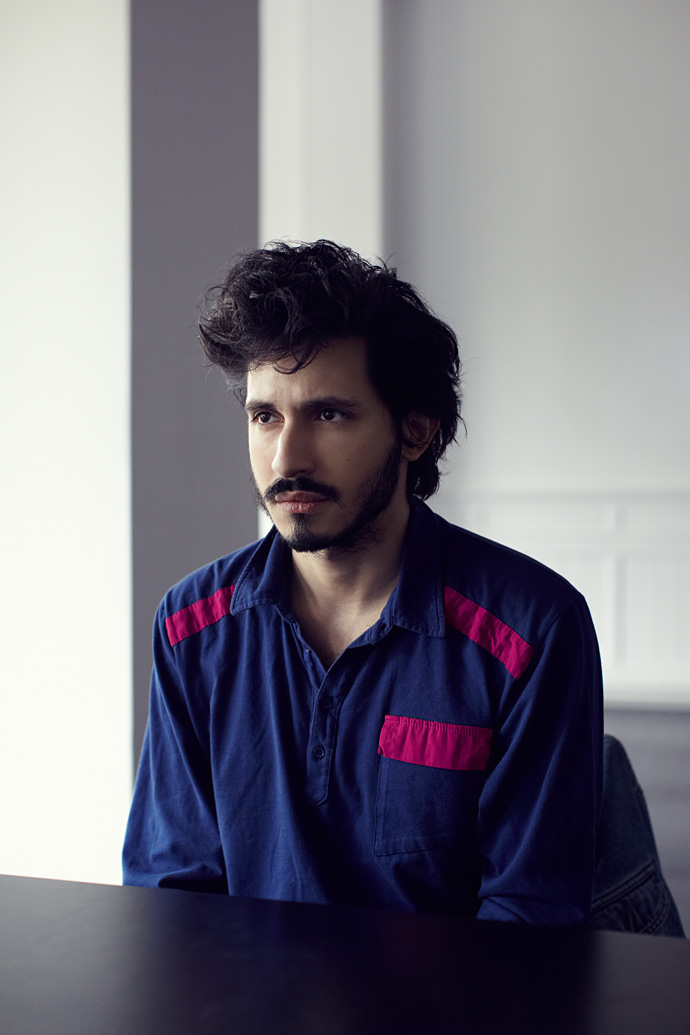 Abdel Bounane at AMUSEMENT gallery, by René Habermacher.
Abdel Bounane at AMUSEMENT gallery, by René Habermacher.Antoine Asseraf : So where are we, there’s a store downstairs, but this is something else…
Abdel Bounane: This is the space where soon we will offer services and events linked to the store, and to the magazine.
The service part is probably the most interesting, because this is going to be the most original part.
For the store we try to have some original products, but for services, starting in May, you’ll be able to order a tailor-made video game.You make an appointment, meet with one of our consultants, and give your craziest ideas regarding what you want from a video game, and we’ll be able to materialize it. It can take a few days, a few weeks, or sometimes a few months, it can cost a few hundred or a few thousand euros.
It’s a world first.
It answers the question “if you want to make a space linked to the digital world, how do you offer something original and human ?”Something that doesn’t lag behind the virtual world.
Exactly. What is the use of being in the real world when you’re talking about the virtual ?
So for me, it is the meeting with people, the ability to explain face to face your ideas, a human and interactive touch, it’s fundamentally linked to a physical place. It wouldn’t be the same thing by Skype.That’s one part of the services we will offer.
We will also offer a gallery side.
People have been trying to sell digital art for decades now, and they haven’t really been able to, except for installations which hard to sustain. But now tablets are here, and I feel that tablets are a good media for that art, like a canvas.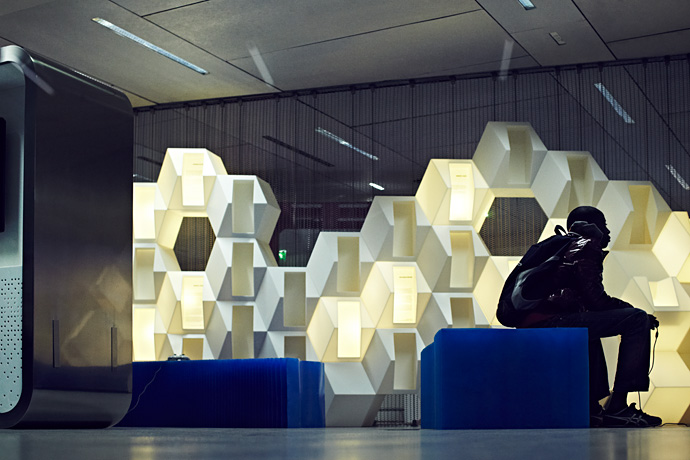 The ressource center of the Gaïté Lyrique. By René Habermacher.
The ressource center of the Gaïté Lyrique. By René Habermacher.That makes me think of that bloom application for iPhone, by Brian Eno…
Well, Brian Eno’s been here !
What we’re developing is the sell of pieces on tablets, offline, and also an online store of limited edition digital content, with a certificate of authenticity on our servers.How do you co-exist with the Gaïté Lyrique proper?
Well with the digital art we’re going to be working a lot with artists from the Gaïté, such as Matt Pyke/Universal Everything,
They do a lot of cool particle effects, very pop, very colorful, and they’re don’t want something that is all over the internet, just something that is visible physically at the Gaïté, because it’s a site-specific installation, and potentially sold digitally.That’s where the logic of the Gaïté comes in, it’s not a museum, it’s a creation center.
So it’s perfect for us, we become the distributors of content that cannot be found elsewhere, and digital limited edition fits the Gaïté perfectly.We’re not only the commercial arm of the Gaïté, we’re here to play with new ways of crossing art and digital, video games and one-to-one distribution, or take a mass media like video games and make it personalized, how do me make something pop more haute ?
How to legitimize a physical location, with launches, workshops, etc.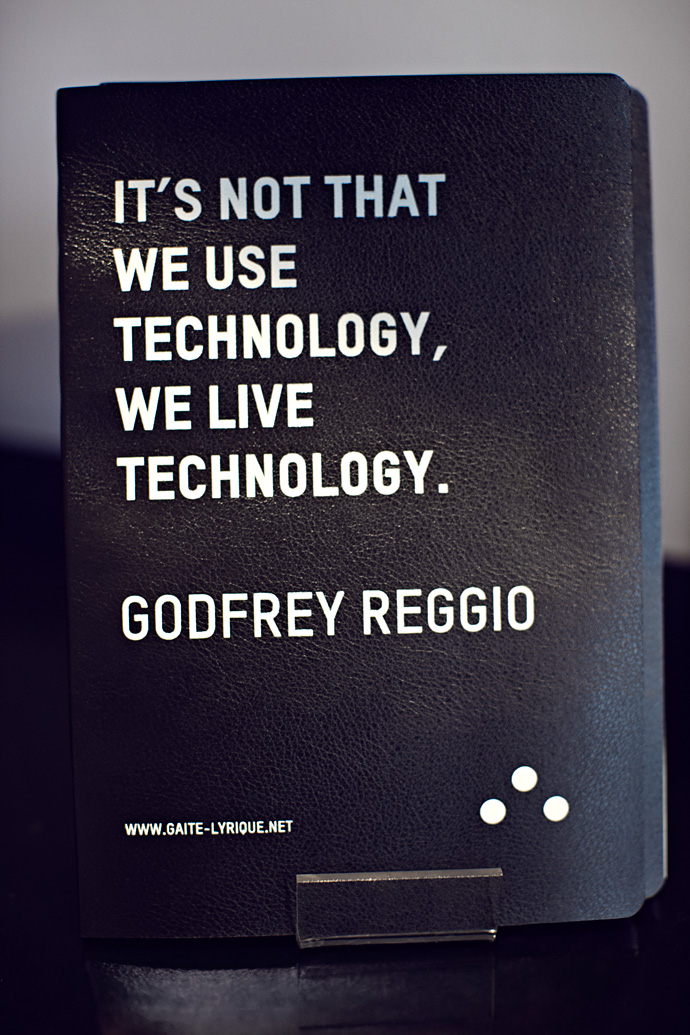 Gaïté Lyrique communication.
Gaïté Lyrique communication. -

Efi Spyrou “swings”
-Cypriot Artist Efi Spyrou “swings” to our attention with the latest issue of Pop magazine SS 2011.
Efi Spyrou’s artistic reflection is interdisciplinary, her art on the conjunction of corporality and art theory. Often her approach, as manifested through her pieces and installations, seems cold and industrial. Yet it is charged with personal memories associating emotional moments. Remarkably enough, Efi operates with inhibiting elements of isolation, institutionalisation and discipline to achieve her purpose: ignite an emotional spark.
Efi Spyrou: Swing (1), 2010 marble, latex; 285 x 30 x 15cm. Photo by René Habermacher for PoP magazine SS 2011. Model: Ymre Stimkema.
This Issue of Pop magazine features a group of 5 contemporary artists: Gillian Wearing, Meredith Sparks, Linda Sterling, Clunie Reid and Efi Spyrou, Juxtaposing pieces of her SWING series with fashion by Antonio Marras, her work for this collaboration oscillates around the idea of “lost innocence”.
At this Chapter of her Life, Efi Spyrou contemplates inwards, both on personal and collective memory – after being in the spotlight as a fashion model, presenter and public figure that stood for the right cause:
She was involved in Campaigns of public interest as against eating disorders, “Fashion Targets Breast Cancer” and the UNHCR-the UN refugee Agencies ‘Against Women Trafficking’ and was subsequently awarded with the Cyprus “Leader of the Year in Advertisement”.
THE STIMULEYE finds Efi Spyrou in Athens, her hometown of choice for a conversation on her most recent projects,
including her first solo exhibition at Six D.O.G.S in Athens. The exhibition will run from May 6 2011.Efi Spyrou: Untitled, 2010, latex, iron, plexiglas, wood; 85 x 65 x 120
EFI SPYROU: Hi Rene! Here I am!
RENE HABERMACHER: hey hey- just saw you! welcome!!!!!
I think now it’s a good time for our conversation! Shall we?
In your work we find often references to childhood, as in your most recent SWING series, but as well for example in “Untitled” 2010 (incubator). What is the relation to yourself?
Each detail, each piece reflected on my work is connected to my memories, my experiences especially in my early ages. Sometimes I feel I was literally thrown from childhood to adulthood in an instant moment… There is an inner need to go back again and start from scratch, with a different pace.
How did you grow up?
In a very disciplined way…
I grew up in a very small, conservative, strict, disciplined community where freedom of speech was not something really known… After my 18th birthday, when I decided to leave my homeland Cyprus, I was catapulted into the wild world of which I knew nothing about! And first of all, I knew nothing about rapacity…I was 18 years but I had the feeling to be in fact much, much younger and very scared.
Following your journey had taken you quite somewhere else- in terms of location and orientation. You returned only much later to your point of departure, with your art and the themes your current work embraces.
After 17 years I am in the position to say that this journey was difficult but full of colours, aromas and sounds, the voices of different cultures, people, moments. You see, I have entered the fashion world as a model and subsequently public figure, which gave me the chance to travel a lot all over the world. Although I had great moments, and I do feel lucky about it – I had to test my limits, my values and myself in many ways: In this race the cost was not insignificant. That is why there was a turning point, of explosion, – I had to slow down – and turn the time back, back to my roots and see which were the remains! This is where art gave me the tools to deal with all this material I had in my hands…
Efi Spyrou: Swing (2), 2010, silicone, latex; 75 x 30 x 15cm. Photo by René Habermacher for PoP magazine SS 2011. Model: Ymre Stimkema.
When we met last time in London to do our project for POP, we were focusing on your most recent work, the SWING. In fact it was a juxtaposition of your art with the fashion by Antonio Marras, under the helm of Isabelle Kountoure. It seemed like another circle had closed: with this new pieces that reflect on lost innocence and the interweaving with fashion that had marked another phase of your life.
This was a liberating experience for me. Every time I find the medium to make a conclusion of my contradicting “memory voices”… is an exciting moment. With the series of my works SWING, I had the chance to cooperate with a great team, working on the upside of fashion. And in parallel I had the chance to give light to a darker “space” as you say, “our lost innocence”. This is the only way for me to survive- to accept my bipolarity…
You started with the first piece of your “swing”series in marble. For this project you took cooperations with other people in account – thus creating more facets around the actual object…
The first piece was more an inner conversation. The development of the piece[s] through this cooperation was a conversation with others! This is really important for me, because I do believe that our personal “spaces” from a different perspective are collective “spaces”. The former is the reflection of the latter and vice versa!
In art, the material plays a significant role in the interpretation of the piece.
During our collaborative working process i’ve developed other variants of the original swing: wax, silicone, plaster and mirror. Doing so, I leave an open interpretation of my recent Swings”. What matters to me, is not to give a solution to a problem, but to actually “spark off” something…Swing (3), 2010 by Efi Spyrou: paraffin wax, latex; 335 x 30 x 15cm. Photo by René Habermacher for PoP magazine SS 2011.
As you operate not only plenty with personal memories, but integrate the collective as well – in this context, how important is Athens, or Greece as a background for your work?
For my own work I incorporate a universal, collective memory in my pieces – at least this is what I am trying to do. Sometimes it could be characterised more “western”… but not surely Greek or Cypriot. I can assure you though that my life in Athens and especially the “new” way I look at the city and its everyday life here, gives birth to a lot of new ideas + questions + art pieces!
Spring, especially these days, is so refreshing! I cannot think of economic crisis – I keep my worries silent for the moment.
As far as concerning the emerging art scene over here: I think there is a lot to be done, in order to consider Athens as part of the greater art map. But I see a young art generation which is very promising…What are you working on right now and next?
I am preparing a solo exhibition in May. The show will be running from May 6th at the Six D.O.G.S exhibition space in Athens. Included on display are among new works some ready pieces that are already known.
For the moment I am studying the relationship of memory with the game of lights and shades in space. I am working on sketches right now, may be for an installation, we will see…
I would love to have the chance for more collective dialogues in the future.Efi Spyrou: Swing (2), 2010, silicone, latex; 75 x 30 x 15cm. Photo by René Habermacher for PoP magazine SS 2011.
Thank you so much for this insightful talk!
Shall I say sweet dreams?
Efi Spirou’s solo exhibition at Six D.O.G.S, 6-8 Avramiotou Street, 10551, Athens, Greece
The exhibition will run from May 6 2011.a collaboration EFI SPYROU | ANTONIO MARRAS pop Magazine SS 2011
Hair Panos Papandrianos at CLM using Bumble and bumble
Make-up Yannis Siskos at Effex using Giorgio Armani Cosmetics
Model Ymre Stiekema at Viva London
Casting Angus Munro at AM Casting, Streeters NY
Set Design Emily Pugh
Photography Assistance & Digital Technician Laurent Dubin
Fashion Assistance Tui Lin
Hair Assistance Angel Sayers
Digital Remastering Dimitri Rigas at Dimitri.jp
Shot at The Russian Club Studios
